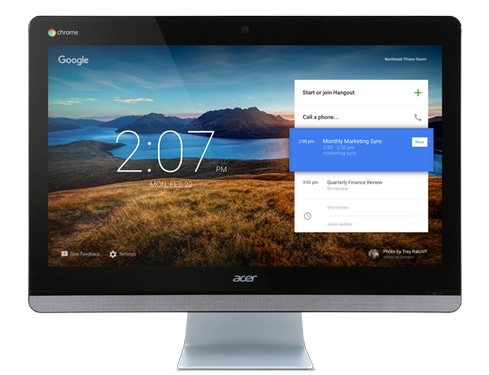Acer Chromebase Makes Video Conferencing Affordable
Google and Acer are looking to make video conference more affordable with the release of the $799 Chromebase. In addition to the price, the device is designed to foster video conferencing in small groups.


8 IT Projects To Prioritize When Budget's Tight
8 IT Projects To Prioritize When Budget's Tight (Click image for larger view and slideshow.)
Google and Acer are teaming up to making video conferencing easier, as well as affordable, with the release of the Chromebase, an all-in-one secure video-conferencing device optimized for use in small meeting areas with up to two people.
Starting at $799 -- including the $250 annual management and support fee --the Acer Chromebase for meetings features a 24-inch LED touchscreen with 720p HD adjustable camera, as well as a four-speaker microphone array for improved video and audio quality.
The device runs on an Intel Celeron dual-core processor with Google video acceleration. It also includes 4GB of memory and features 802.11ac WiFi, Bluetooth 4.0, and Gigabit LAN Ethernet connectivity options.
In addition, guest account support makes it possible to join a meeting even without a Google account. Users can click a meeting link invitation and can get connected.
Google also announced additional features to their remote fleet management tools, which means administrators can now receive alert notifications and track health of their fleet of Chrome devices for meetings.

Create a culture where technology advances truly empower your business. Attend the Leadership Track at Interop Las Vegas, May 2-6. Register now!
Admins can also remotely diagnose and troubleshoot audio, video quality, and bandwidth problems, as well as customize the interface using their own background images.
Acer is also offering a special deal where businesses can try two Chromebase for meetings devices at no cost for 30 days and receive special promotion pricing of $549 per device with first year's management and support fee included.
If the business is not a Chromebox for meetings customer, the program will provide it with two trial Chrome Device Management licenses, each for a license period of 12 months, at no cost, for use with the Chromebase for meetings devices.
Google and Acer officially announced the Chromebase in a March 31 post on the Google For Work blog.
The release follows Microsoft's announcement that the Surface Hub, its oversized unified communications offering, is finally shipping to customers after a number of delays. This monster PC comes as a wall-mounted or roller stand-mounted device with an 84-inch, 120 Hz 4K, or a 55-inch 1080p, multi-touch and multi-pen screen.
The Surface Hub starts at a hefty $9,000 for the smaller model, while the fully-loaded, 84-inch version retails for a whopping $21,999.
For that price, however, businesses get far more capabilities than the basic feature set offered by the Chromebox. For example, meeting participants can write on the display or annotate images from a connected PC or tablet.
The screen is then designed to recognize the difference between fingers and digital pens, so a presenter can manipulate content by hand and annotate with a pen.
In addition, Skype for Business can be used to write and edit text, invite participants, and collaborate via videoconference. Participants can also co-author documents and view pixel-by-pixel activity in real-time.
The new offerings from Microsoft and Acer are essentially large touchscreens designed for communication and meetings, but Microsoft is also working on moving into the third dimension with the development of what it calls holoportation.
Holoportation is a new type of 3D-capture technology that allows high-quality models of people to be reconstructed, compressed, and transmitted anywhere in the world in real-time.
Designed by Microsoft Research's Interactive 3D Technologies group, the project combines research on 3D graphics, computer vision, machine learning, novel hardware, augmented reality, and natural user interface (NUI) technology.

About the Author(s)
You May Also Like
How to Amplify DevOps with DevSecOps
May 22, 2024Generative AI: Use Cases and Risks in 2024
May 29, 2024Smart Service Management
June 4, 2024







